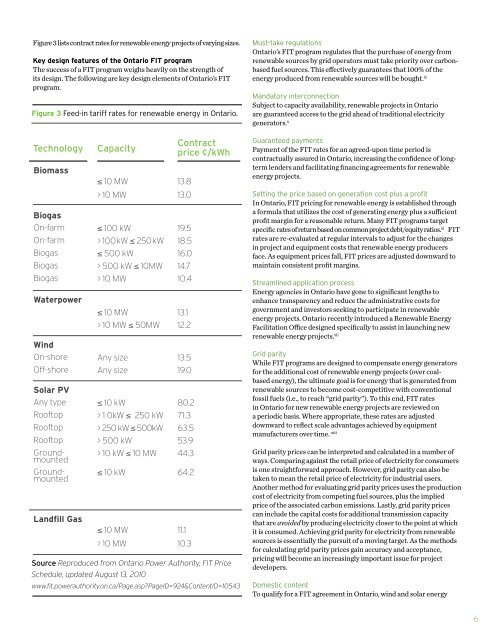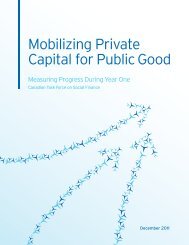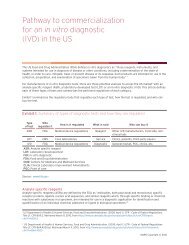Feed-in tariffs Accelerating renewable energy project development ...
Feed-in tariffs Accelerating renewable energy project development ...
Feed-in tariffs Accelerating renewable energy project development ...
You also want an ePaper? Increase the reach of your titles
YUMPU automatically turns print PDFs into web optimized ePapers that Google loves.
Figure 3 lists contract rates for <strong>renewable</strong> <strong>energy</strong> <strong>project</strong>s of vary<strong>in</strong>g sizes.<br />
Key design features of the Ontario FIT program<br />
The success of a FIT program weighs heavily on the strength of<br />
its design. The follow<strong>in</strong>g are key design elements of Ontario’s FIT<br />
program.<br />
Figure 3 <strong>Feed</strong>-<strong>in</strong> tariff rates for <strong>renewable</strong> <strong>energy</strong> <strong>in</strong> Ontario.<br />
Technology<br />
Biomass<br />
Biogas<br />
On-farm<br />
On-farm<br />
Biogas<br />
Biogas<br />
Biogas<br />
Waterpower<br />
W<strong>in</strong>d<br />
On-shore<br />
Off-shore<br />
Solar PV<br />
Any type<br />
Rooftop<br />
Rooftop<br />
Rooftop<br />
Groundmounted<br />
Groundmounted<br />
Landfill Gas<br />
Capacity<br />
≤ 10 MW<br />
> 10 MW<br />
≤ 100 kW<br />
> 100kW ≤ 250kW<br />
≤ 500 kW<br />
> 500 kW ≤ 10MW<br />
> 10 MW<br />
≤ 10 MW<br />
> 10 MW ≤ 50MW<br />
Any size<br />
Any size<br />
≤ 10 kW<br />
> 1 0kW ≤ 250 kW<br />
> 250 kW ≤ 500kW<br />
> 500 kW<br />
> 10 kW ≤ 10 MW<br />
≤ 10 MW<br />
> 10 MW<br />
13.8<br />
13.0<br />
19.5<br />
18.5<br />
16.0<br />
14.7<br />
10.4<br />
80.2<br />
71.3<br />
63.5<br />
53.9<br />
44.3<br />
≤ 10 kW 64.2<br />
Contract<br />
price ¢/kWh<br />
13.1<br />
12.2<br />
13.5<br />
19.0<br />
11.1<br />
10.3<br />
Source Reproduced from Ontario Power Authority, FIT Price<br />
Schedule, updated August 13, 2010<br />
www.fit.powerauthority.on.ca/Page.asp?PageID=924&ContentID=10543<br />
Must-take regulations<br />
Ontario’s FIT program regulates that the purchase of <strong>energy</strong> from<br />
<strong>renewable</strong> sources by grid operators must take priority over carbonbased<br />
fuel sources. This effectively guarantees that 100% of the<br />
<strong>energy</strong> produced from <strong>renewable</strong> sources will be bought. ix<br />
Mandatory <strong>in</strong>terconnection<br />
Subject to capacity availability, <strong>renewable</strong> <strong>project</strong>s <strong>in</strong> Ontario<br />
are guaranteed access to the grid ahead of traditional electricity<br />
generators. x<br />
Guaranteed payments<br />
Payment of the FIT rates for an agreed-upon time period is<br />
contractually assured <strong>in</strong> Ontario, <strong>in</strong>creas<strong>in</strong>g the confidence of longterm<br />
lenders and facilitat<strong>in</strong>g f<strong>in</strong>anc<strong>in</strong>g agreements for <strong>renewable</strong><br />
<strong>energy</strong> <strong>project</strong>s.<br />
Sett<strong>in</strong>g the price based on generation cost plus a profit<br />
In Ontario, FIT pric<strong>in</strong>g for <strong>renewable</strong> <strong>energy</strong> is established through<br />
a formula that utilizes the cost of generat<strong>in</strong>g <strong>energy</strong> plus a sufficient<br />
profit marg<strong>in</strong> for a reasonable return. Many FIT programs target<br />
specific rates of return based on common <strong>project</strong> debt/equity ratios. xi FIT<br />
rates are re-evaluated at regular <strong>in</strong>tervals to adjust for the changes<br />
<strong>in</strong> <strong>project</strong> and equipment costs that <strong>renewable</strong> <strong>energy</strong> producers<br />
face. As equipment prices fall, FIT prices are adjusted downward to<br />
ma<strong>in</strong>ta<strong>in</strong> consistent profit marg<strong>in</strong>s.<br />
Streaml<strong>in</strong>ed application process<br />
Energy agencies <strong>in</strong> Ontario have gone to significant lengths to<br />
enhance transparency and reduce the adm<strong>in</strong>istrative costs for<br />
government and <strong>in</strong>vestors seek<strong>in</strong>g to participate <strong>in</strong> <strong>renewable</strong><br />
<strong>energy</strong> <strong>project</strong>s. Ontario recently <strong>in</strong>troduced a Renewable Energy<br />
Facilitation Office designed specifically to assist <strong>in</strong> launch<strong>in</strong>g new<br />
<strong>renewable</strong> <strong>energy</strong> <strong>project</strong>s. xii<br />
Grid parity<br />
While FIT programs are designed to compensate <strong>energy</strong> generators<br />
for the additional cost of <strong>renewable</strong> <strong>energy</strong> <strong>project</strong>s (over coalbased<br />
<strong>energy</strong>), the ultimate goal is for <strong>energy</strong> that is generated from<br />
<strong>renewable</strong> sources to become cost-competitive with conventional<br />
fossil fuels (i.e., to reach “grid parity”). To this end, FIT rates<br />
<strong>in</strong> Ontario for new <strong>renewable</strong> <strong>energy</strong> <strong>project</strong>s are reviewed on<br />
a periodic basis. Where appropriate, these rates are adjusted<br />
downward to reflect scale advantages achieved by equipment<br />
manufacturers over time. xiii<br />
Grid parity prices can be <strong>in</strong>terpreted and calculated <strong>in</strong> a number of<br />
ways. Compar<strong>in</strong>g aga<strong>in</strong>st the retail price of electricity for consumers<br />
is one straightforward approach. However, grid parity can also be<br />
taken to mean the retail price of electricity for <strong>in</strong>dustrial users.<br />
Another method for evaluat<strong>in</strong>g grid parity prices uses the production<br />
cost of electricity from compet<strong>in</strong>g fuel sources, plus the implied<br />
price of the associated carbon emissions. Lastly, grid parity prices<br />
can <strong>in</strong>clude the capital costs for additional transmission capacity<br />
that are avoided by produc<strong>in</strong>g electricity closer to the po<strong>in</strong>t at which<br />
it is consumed. Achiev<strong>in</strong>g grid parity for electricity from <strong>renewable</strong><br />
sources is essentially the pursuit of a mov<strong>in</strong>g target. As the methods<br />
for calculat<strong>in</strong>g grid parity prices ga<strong>in</strong> accuracy and acceptance,<br />
pric<strong>in</strong>g will become an <strong>in</strong>creas<strong>in</strong>gly important issue for <strong>project</strong><br />
developers.<br />
Domestic content<br />
To qualify for a FIT agreement <strong>in</strong> Ontario, w<strong>in</strong>d and solar <strong>energy</strong><br />
6















